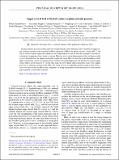Upper critical field of Sr2RuO4 under in-plane uniaxial pressure
Abstract
In-plane uniaxial pressure has been shown to strongly tune the superconducting state of Sr2RuO4 by approaching a Lifshitz transition and associated Van Hove singularity (VHS) in the density of states. At the VHS, Tc and the in- and out-of-plane upper critical fields are all strongly enhanced, and the latter has changed its curvature as a function of temperature from convex to concave. However, due to strain inhomogeneity it has not been possible so far to determine how the upper critical fields change with strain. Here, we show the strain dependence of both upper critical fields, which was achieved due to an improved sample preparation. We find that the in-plane upper critical field is mostly linear in Tc. On the other hand, the out-of-plane upper critical field varies with a higher power in Tc, and peaks strongly at the VHS. The strong increase in magnitude and the change in form of Hc2||c occur very close to the Van Hove strain, and point to a strong enhancement of both the density of states and the gap magnitude at the Lifshitz transition.
Citation
Jerzembeck , F , Steppke , A , Pustogow , A , Luo , Y , Chronister , A , Sokolov , D A , Kikugawa , N , Li , Y-S , Nicklas , M , Brown , S E , Mackenzie , A P & Hicks , C W 2023 , ' Upper critical field of Sr 2 RuO 4 under in-plane uniaxial pressure ' , Physical Review B , vol. 107 , no. 6 , 064509 . https://doi.org/10.1103/PhysRevB.107.064509
Publication
Physical Review B
Status
Peer reviewed
ISSN
2469-9950Type
Journal article
Description
Funding: F.J., A.P.M., and C.W.H. acknowledge the financial support of the Deutsche Forschungsgemeinschaft (DFG, German Research Foundation) TRR 288-422213477 (Project A10). A.P. acknowledges support by the Alexander von Humboldt Foundation through a Feodor Lynen fellowship during his work at UCLA. N.K. is supported by KAKENHI Grants-in-Aids for Scientific Research (Grants No. 18K04715, No. 21H01033, and No. 22K19093), Core-to-Core Program (No. JPJSCCA20170002) from the Japan Society for the Promotion of Science (JSPS), and the JST-Mirai Program (Grant No. JPMJMI18A3). A.C. is grateful for support from the Julian Schwinger Foundation for Physics Research. The work at University of California, Los Angeles, was supported by NSF Grant No. 2004553.Collections
Items in the St Andrews Research Repository are protected by copyright, with all rights reserved, unless otherwise indicated.

